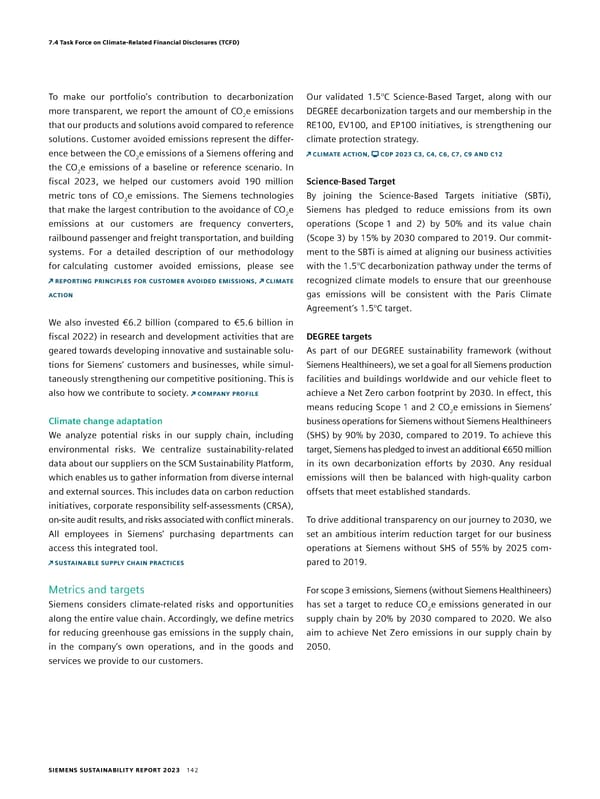7.4 Task Force on ClimateRelated Financial Disclosures (TCFD) To make our portfolio’s contribution to decarbonization Our validated 1.5°C Science-Based Target, along with our more transparent, we report the amount of CO e emissions DEGREE decarbonization targets and our membership in the 2 that our products and solutions avoid compared to reference RE100, EV100, and EP100 initiatives, is strengthening our solutions. Customer avoided emissions represent the differ- climate protection strategy. ence between the CO e emissions of a Siemens offering and CLIMATE ACTION, CDP 2023 C3, C4, C6, C7, C9 AND C12 2 the CO e emissions of a baseline or reference scenario. In 2 fiscal 2023, we helped our customers avoid 190 million Science-Based Target metric tons of CO e emissions. The Siemens technologies By joining the Science-Based Targets initiative (SBTi), 2 that make the largest contribution to the avoidance of CO2e Siemens has pledged to reduce emissions from its own emissions at our customers are frequency converters, operations (Scope 1 and 2) by 50% and its value chain railbound passenger and freight transportation, and building (Scope 3) by 15% by 2030 compared to 2019. Our commit- systems. For a detailed description of our methodology ment to the SBTi is aimed at aligning our business activities for calculating customer avoided emissions, please see with the 1.5°C decarbonization pathway under the terms of REPORTING PRINCIPLES FOR CUSTOMER AVOIDED EMISSIONS, CLIMATE recognized climate models to ensure that our greenhouse ACTION gas emissions will be consistent with the Paris Climate Agreement’s 1.5°C target. We also invested €6.2 billion (compared to €5.6 billion in fiscal 2022) in research and development activities that are DEGREE targets geared towards developing innovative and sustainable solu- As part of our DEGREE sustainability framework (without tions for Siemens’ customers and businesses, while simul- Siemens Healthineers), we set a goal for all Siemens production taneously strengthening our competitive positioning. This is facilities and buildings worldwide and our vehicle fleet to also how we contribute to society. COMPANY PROFILE achieve a Net Zero carbon footprint by 2030. In effect, this means reducing Scope 1 and 2 CO e emissions in Siemens’ 2 Climate change adaptation business operations for Siemens without Siemens Healthineers We analyze potential risks in our supply chain, including (SHS) by 90% by 2030, compared to 2019. To achieve this environmental risks. We centralize sustainability-related target, Siemens has pledged to invest an additional €650 million data about our suppliers on the SCM Sustainability Platform, in its own decarbonization efforts by 2030. Any residual which enables us to gather information from diverse internal emissions will then be balanced with high-quality carbon and external sources. This includes data on carbon reduction offsets that meet established standards. initiatives, corporate responsibility self-assessments (CRSA), on-site audit results, and risks associated with conflict minerals. To drive additional transparency on our journey to 2030, we All employees in Siemens' purchasing departments can set an ambitious interim reduction target for our business access this integrated tool. - operations at Siemens without SHS of 55% by 2025 com SUSTAINABLE SUPPLY CHAIN PRACTICES pared to 2019. Metrics and targets For scope 3 emissions, Siemens (without Siemens Healthineers) Siemens considers climate-related risks and opportunities has set a target to reduce CO e emissions generated in our 2 along the entire value chain. Accordingly, we define metrics supply chain by 20% by 2030 compared to 2020. We also for reducing greenhouse gas emissions in the supply chain, aim to achieve Net Zero emissions in our supply chain by in the company’s own operations, and in the goods and 2050. services we provide to our customers. SIEMENS SUSTAINABILITY REPORT 2023 142
 Sustainability Report Page 141 Page 143
Sustainability Report Page 141 Page 143